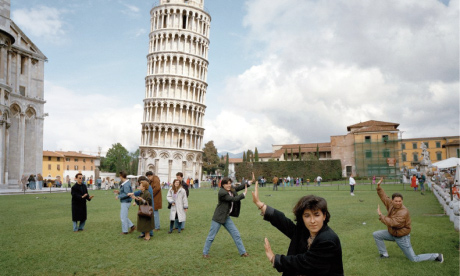
There are at least three Venices. There's the one the holiday brochures would have us believe is real - a city of mist-shrouded canals, ornate bridges and occasional masked figures disappearing enigmatically down narrow alleyways. There's the real Venice, a beautiful but crowded theme park where tourists outnumber local people two-to-one. And there's the completely fake Venice which has been built around a casino in Las Vegas. It is in the spaces between these three cities - between expectation and reality and artificiality - that the photographer Martin Parr finds his inspiration.
Parr, who cut his teeth as a holiday snapper at Butlins in Filey, made his name documenting a particular kind of Englishness. From flock-wallpapered front rooms to the kiss-me-quick tackiness of the British seaside, he captured the eccentric, the garish and the banal. In Small World, his 1995 book of photographs which is reissued this week with new and more recent material, he takes his camera abroad.
A Korean tour group poses for photos in front of the Acropolis. Guides tout for business in a square in Prague. Vendors wave their trinkets at tourists who try to ignore them. The tourists are often gaudily dressed in Hawaiian shirts and baseball caps or T-shirts that advertise previous destinations they have visited. The attractions, whether it be the Notre Dame cathedral in Paris or the pyramids of Egypt, play second fiddle to the hubbub of tourist and commercial activity which is taking place around them.
Parr denies that he actively seeks out the ugly or the gaudy. 'If there is any jarring at all in my photographs, it's because we are so used to ingesting pictures of everywhere looking beautiful,' he says. 'We are surrounded by propaganda, whether it be in travel supplements or holiday brochures or advertising. I just show things as I see them.'
He is fascinated by the myths on which the tourism industry is built. Holiday brochures sell us the dream of the deserted beach, the undiscovered city, the authentic cafe, the friendly local people. When we get there to find a coach party of Germans has just arrived, what do we do? We set about recreating that myth. With our cameras we edit out the other tourists, waiting for them to move out of the way so we can replicate the brochure image which inspired us to travel there in the first place. With our holiday snaps we create a kind of propaganda, contriving our own positive memories.
Seen through Parr's lens, foreign travel becomes a curiously joyless undertaking. Grim-faced tourists file through the Basilica di San Marco in Venice wearing matching plastic rain ponchos. Passengers at Tenerife airport await their flights, their body language screaming boredom and frustration. Any interaction between tourists and local people is of a strictly commercial nature. It's grim but it's not without humour; Parr has a talent for revealing the absurdity of any given scenario. A fake gondolier takes a photograph of real tourists at the Venetian hotel in Las Vegas. Parr brings our attention to the many layers of artificiality that are present.
The cumulative effect of these pictures is a sense of growing claustrophobia. There's simply no escape from the camera-wielding swarms: they are everywhere, blocking the view of the sights we have come to see, posing in front of the Pyramids, cluttering up the Spanish Steps. The travel writer Patrick Leigh Fermor described tourism as 'that gregarious passion which destroys the thing it loves'. Parr shows us that the act of travelling to a place inevitably changes its nature. Or, as the author Geoff Dyer puts it in his introduction to Small World: 'Wherever you travel some kind of industry develops to cater for you - even if it's not the kind of catering you, personally, were hoping for.'
It's almost impossible to view Parr's photographs without a sense of detachment and superiority. They are the tourists of popular stereotype, garishly-dressed consumers, unthinking and unseeing, following the herd. We, on the other hand, are 'travellers'. You won't catch us taking a gondola ride or having our portrait painted in Montmartre (unless of course it's in a terribly knowing and ironic way). But Parr's pictures show us that the commercial machine does not discriminate between tourists and travellers. Whatever our motives for travelling to Rome, whether they be religious, hedonistic, academic, or merely so that we can say we've been there, once there we all become consumers.
The pictures in the book span almost 20 years, a period in which the combination of cheap air travel and increased global wealth have had a huge impact on the number of people travelling. This trend shows no sign of slowing down. The popular tourist sights will become more congested. The more affluent and adventurous will seek farther-flung corners of the globe. Two hundred years before the first charter flights took off, Samuel Johnson wrote: 'The use of travelling is to regulate imagination by reality, and instead of thinking how things may be, to see them as they are.' Alternatively you could have a look at this book and save yourself the air fare.
· Small World by Martin Parr is published by Dewi Lewis Publishing at £25. To order a copy for £22 with free UK p&p go to our bookshop or call 0870 836 0885

